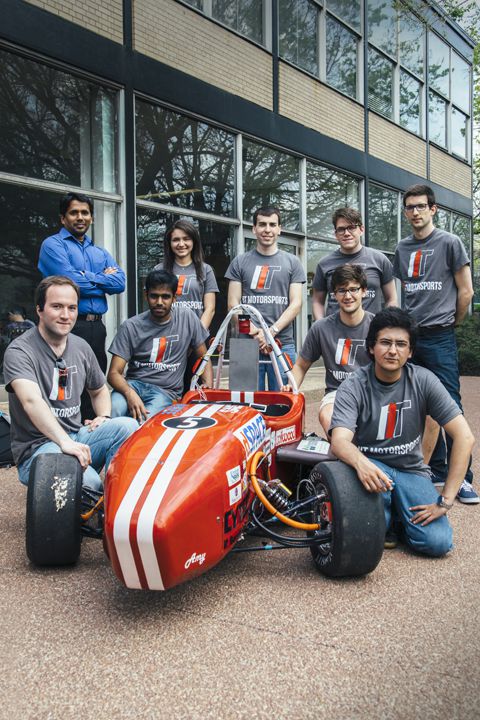Battery
The car uses the energy from the battery directly to run the motors, and the motors run the wheels. An ultra-capacitor, pouch-cell lithium battery (composed of about 150 cells) originally powered WISER Tomahawk. The team has since obtained a prismatic-cell battery, which it will use to power the car in the spring 2016 competition. As these cells are flat in structure, the battery requires only about 80 cells to run the motors. The battery is housed under the driver’s seat.
Begin
Next
Gentlemen (and Ladies)
Start Your Batteries!
Previous
Body (or monocoque, French for “single shell”)
Made out of carbon fiber, WISER Tomahawk weighs only 400 lbs.; Hammer Hawk weighed a hefty 800 lbs. The Illinois Tech team learned the arduous construction process with the help of Sammy Tin, professor of materials engineering. The only steel in the car is the roll hoop and the front roll hoop.
WISER Tomahawk, the latest generation of built-from-the-ground-up IIT Motorsports Formula SAE vehicles, follows a line-up of other successful racecars that were designed and largely fabricated by Illinois Tech students: Red Rocket, Scarlet Hawk, Hammer Hawk, and Thunder Hawk. One of WISER Tomahawk’s greatest improvements is a weight reduction by 50 percent from the Hammer Hawk of two generations ago.
View innovations that made the all-electric WISER Tomahawk
an award winner at the 2015 Formula Hybrid collegiate competition.
Wheels
Since it does not have an engine, WISER Tomahawk is powered through its wheels by built-in, permanent-magnet hub motors, which are lightweight (about 20 lbs. each) and high-performance. The car has four-wheel drive and a full-torque vectoring system, hence no drive shafts. The wheels are water-cooled to dissipate heat.
Body (or monocoque, French for “single shell”)
Made out of carbon fiber, WISER Tomahawk weighs only 400 lbs.; Hammer Hawk weighed a hefty 800 lbs. The Illinois Tech team learned the arduous construction process with the help of Sammy Tin, professor of materials engineering. The only steel in the car is the roll hoop and the front roll hoop.
Wheels
Since it does not have an engine, WISER Tomahawk is powered through its wheels by built-in, permanent-magnet hub motors, which are lightweight (about 20 lbs. each) and high-performance. The car has four-wheel drive and a full-torque vectoring system, hence no drive shafts. The wheels are water-cooled to dissipate heat.
Gentlemen (and Ladies)
Start Your Batteries!
Battery
The car uses the energy from the battery directly to run the motors, and the motors run the wheels. An ultra-capacitor, pouch-cell lithium battery (composed of about 150 cells) originally powered WISER Tomahawk. The team has since obtained a prismatic-cell battery, which it will use to power the car in the spring 2016 competition. As these cells are flat in structure, the battery requires only about 80 cells to run the motors. The battery is housed under the driver’s seat.
Body (or monocoque, French for “single shell”)
Made out of carbon fiber, WISER Tomahawk weighs only 400 lbs.; Hammer Hawk weighed a hefty 800 lbs. The Illinois Tech team learned the arduous construction process with the help of Sammy Tin, professor of materials engineering. The only steel in the car is the roll hoop and the front roll hoop.
Wheels
Since it does not have an engine, WISER Tomahawk is powered through its wheels by built-in, permanent-magnet hub motors, which are lightweight (about 20 lbs. each) and high-performance. The car has four-wheel drive and a full-torque vectoring system, hence no drive shafts. The wheels are water-cooled to dissipate heat.
WISER Tomahawk, the latest generation of built-from-the-ground-up IIT Motorsports Formula SAE vehicles, follows a line-up of other successful racecars that were designed and largely fabricated by Illinois Tech students: Red Rocket, Scarlet Hawk, Hammer Hawk, and Thunder Hawk. One of WISER Tomahawk’s greatest improvements is a weight reduction by 50 percent from the Hammer Hawk of two generations ago.
View innovations that made the all-electric WISER
Tomahawk an award winner at the 2015 Formula
Hybrid collegiate competition.
Gentlemen (and Ladies), Start Your Batteries!
Battery
The car uses the energy from the battery directly to run the motors, and the motors run the wheels. An ultra-capacitor, pouch-cell lithium battery (composed of about 150 cells) originally powered WISER Tomahawk. The team has since obtained a prismatic-cell battery, which it will use to power the car in the spring 2016 competition. As these cells are flat in structure, the battery requires only about 80 cells to run the motors. The battery is housed under the driver’s seat.
Body (or monocoque, French for “single shell”)
Made out of carbon fiber, WISER Tomahawk weighs only 400 lbs.; Hammer Hawk weighed a hefty 800 lbs. The Illinois Tech team learned the arduous construction process with the help of Sammy Tin, professor of materials engineering. The only steel in the car is the roll hoop and the front roll hoop.
Gentlemen (and Ladies), Start Your Batteries!
Wheels
Since it does not have an engine, WISER Tomahawk is powered through its wheels by built-in, permanent-magnet hub motors, which are lightweight (about 20 lbs. each) and high-performance. The car has four-wheel drive and a full-torque vectoring system, hence no drive shafts. The wheels are water-cooled to dissipate heat.
Battery
The car uses the energy from the battery directly to run the motors, and the motors run the wheels. An ultra-capacitor, pouch-cell lithium battery (composed of about 150 cells) originally powered WISER Tomahawk. The team has since obtained a prismatic-cell battery, which it will use to power the car in the spring 2016 competition. As these cells are flat in structure, the battery requires only about 80 cells to run the motors. The battery is housed under the driver’s seat.
